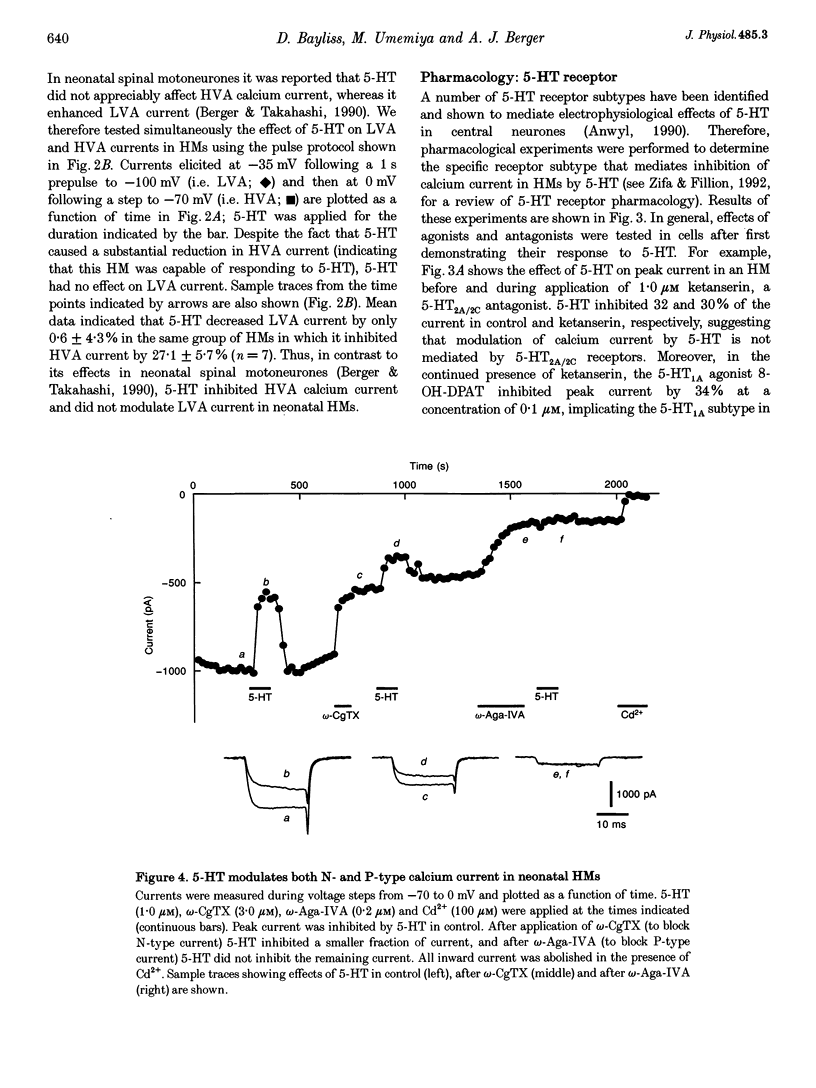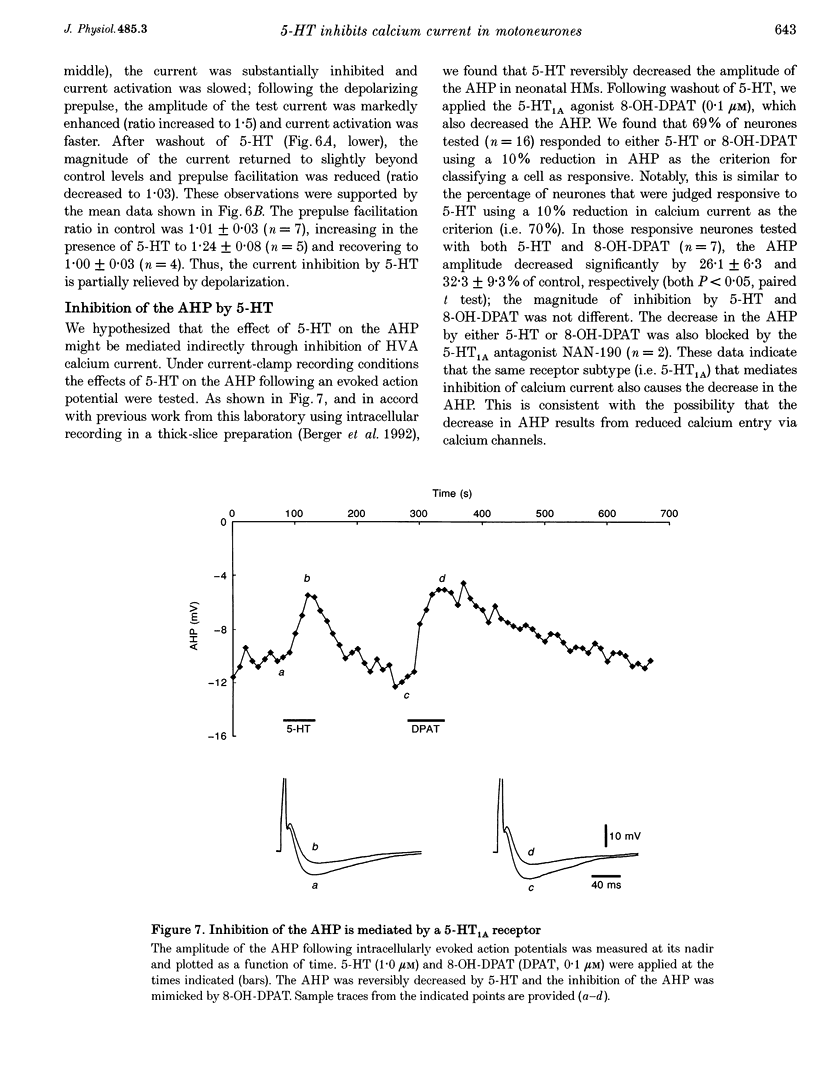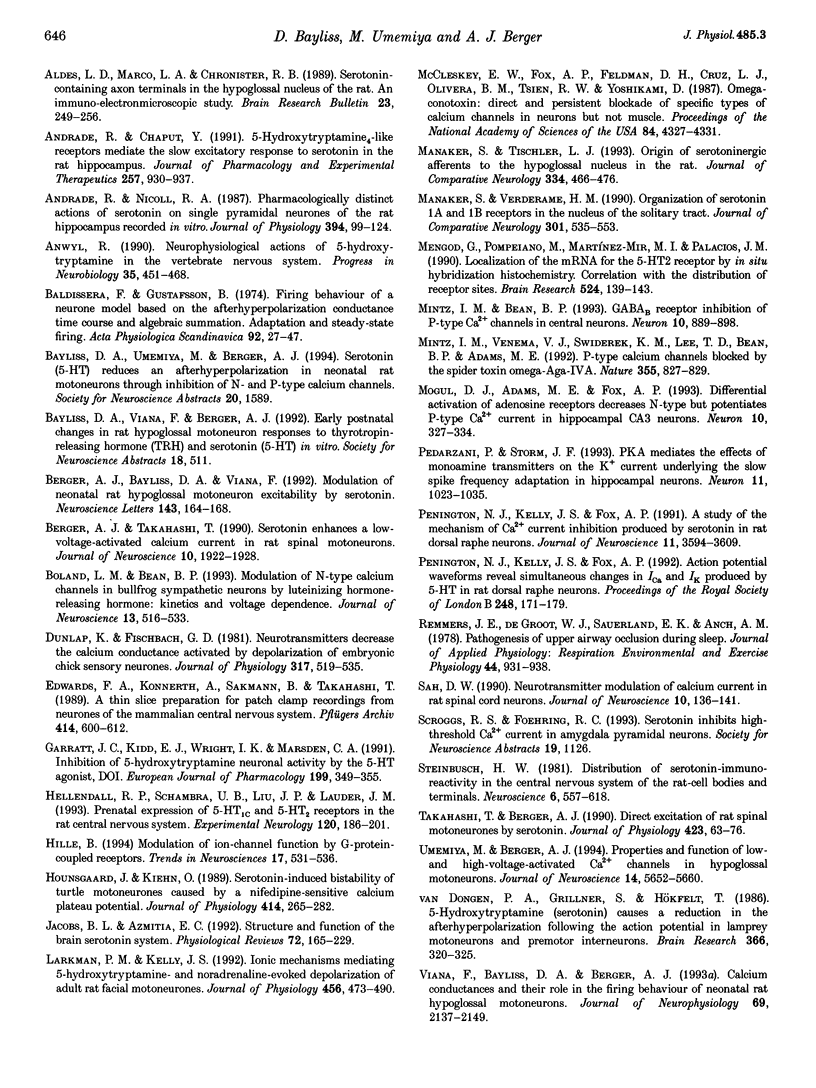Abstract
1. We investigated the effects of serotonin (5-hydroxytryptamine, 5-HT) on whole-cell barium currents through calcium channels in visualized neonatal rat hypoglossal motoneurones (HMs) in a thin brainstem slice preparation. 2. High voltage-activated (HVA) currents were elicited by depolarizing voltage steps from -70 to 0 mV; low voltage-activated (LVA) currents were evoked using steps to between -30 and -40 mV from hyperpolarized potentials (< -80 mV). 5-HT (1.0 microM) inhibited HVA currents by at least 10% in 70% of HMs tested (n = 99); in those responsive neurones, 5-HT decreased HVA current by 22 +/- 1.3% (mean +/- S.E.M.). In contrast, 5-HT had no effect on LVA current amplitude in HMs (n = 7). 3. Calcium current inhibition was mimicked by 5-carboxamidotryptamine maleate (5-CT), a 5-HT1 receptor agonist, and by R(+)-8-hydroxydipropylaminotetralin hydrobromide (8-OH-DPAT), a specific 5-HT1A agonist; N-(3-trifluoromethylphenyl) piperazine hydrochloride (TFMPP), a 5-HT1B agonist, was without effect. The effect of 5-HT was blocked by the 5-HT1A antagonist 1-(2-methoxyphenyl)-4-[4-(2-phthalimido)butyl]piperazine hydrobromide (NAN-190) but not by ketanserin, a 5-HT2A/2C antagonist. Although R(-)-1-(2,5-dimethoxy-4-iodophenyl)-2-aminopropane hydrochloride (DOI), a 5-HT2A/2C agonist, mimicked the current inhibition by 5-HT, it was ineffective in the presence of NAN-190. These data indicate that 5-HT1A receptors mediate calcium current inhibition by 5-HT. 4. Following application of either omega-conotoxin-GVIA (omega-CgTX) or omega-agatoxin-IVA (omega-Aga-IVA), to block N- and P-type components of calcium current, the 5-HT-sensitive current was reduced; 5-HT had no effect on the current remaining after application of both toxins. Thus, 5-HT inhibits both N- and P-type calcium currents in neonatal HMs. 5. Inhibition of HVA current by 5-HT was irreversible, and subsequent applications of 5-HT were occluded, when GTP gamma S was substituted for GTP in the pipette. In addition, inhibition of HVA current by 5-HT was relieved following depolarizing prepulses. These data indicate that inhibition of calcium channels by 5-HT is mediated by G proteins. 6. Under current clamp, both 5-HT and 8-OH-DPAT decreased the amplitude of the after-hyperpolarization (AHP) that followed action potentials, indicating involvement of a 5-HT1A receptor.(ABSTRACT TRUNCATED AT 400 WORDS)
Full text
PDF












Images in this article
Selected References
These references are in PubMed. This may not be the complete list of references from this article.
- Aldes L. D., Marco L. A., Chronister R. B. Serotonin-containing axon terminals in the hypoglossal nucleus of the rat. An immuno-electronmicroscopic study. Brain Res Bull. 1989 Sep;23(3):249–256. doi: 10.1016/0361-9230(89)90154-8. [DOI] [PubMed] [Google Scholar]
- Andrade R., Chaput Y. 5-Hydroxytryptamine4-like receptors mediate the slow excitatory response to serotonin in the rat hippocampus. J Pharmacol Exp Ther. 1991 Jun;257(3):930–937. [PubMed] [Google Scholar]
- Andrade R., Nicoll R. A. Pharmacologically distinct actions of serotonin on single pyramidal neurones of the rat hippocampus recorded in vitro. J Physiol. 1987 Dec;394:99–124. doi: 10.1113/jphysiol.1987.sp016862. [DOI] [PMC free article] [PubMed] [Google Scholar]
- Anwyl R. Neurophysiological actions of 5-hydroxytryptamine in the vertebrate nervous system. Prog Neurobiol. 1990;35(6):451–468. doi: 10.1016/0301-0082(90)90031-b. [DOI] [PubMed] [Google Scholar]
- Baldissera F., Gustafsson B. Firing behaviour of a neurone model based on the afterhyperpolarization conductance time course and algebraical summation. Adaptation and steady state firing. Acta Physiol Scand. 1974 Sep;92(1):27–47. doi: 10.1111/j.1748-1716.1974.tb05720.x. [DOI] [PubMed] [Google Scholar]
- Berger A. J., Bayliss D. A., Viana F. Modulation of neonatal rat hypoglossal motoneuron excitability by serotonin. Neurosci Lett. 1992 Aug 31;143(1-2):164–168. doi: 10.1016/0304-3940(92)90257-8. [DOI] [PubMed] [Google Scholar]
- Berger A. J., Takahashi T. Serotonin enhances a low-voltage-activated calcium current in rat spinal motoneurons. J Neurosci. 1990 Jun;10(6):1922–1928. doi: 10.1523/JNEUROSCI.10-06-01922.1990. [DOI] [PMC free article] [PubMed] [Google Scholar]
- Boland L. M., Bean B. P. Modulation of N-type calcium channels in bullfrog sympathetic neurons by luteinizing hormone-releasing hormone: kinetics and voltage dependence. J Neurosci. 1993 Feb;13(2):516–533. doi: 10.1523/JNEUROSCI.13-02-00516.1993. [DOI] [PMC free article] [PubMed] [Google Scholar]
- Dunlap K., Fischbach G. D. Neurotransmitters decrease the calcium conductance activated by depolarization of embryonic chick sensory neurones. J Physiol. 1981 Aug;317:519–535. doi: 10.1113/jphysiol.1981.sp013841. [DOI] [PMC free article] [PubMed] [Google Scholar]
- Edwards F. A., Konnerth A., Sakmann B., Takahashi T. A thin slice preparation for patch clamp recordings from neurones of the mammalian central nervous system. Pflugers Arch. 1989 Sep;414(5):600–612. doi: 10.1007/BF00580998. [DOI] [PubMed] [Google Scholar]
- Garratt J. C., Kidd E. J., Wright I. K., Marsden C. A. Inhibition of 5-hydroxytryptamine neuronal activity by the 5-HT agonist, DOI. Eur J Pharmacol. 1991 Jul 9;199(3):349–355. doi: 10.1016/0014-2999(91)90499-g. [DOI] [PubMed] [Google Scholar]
- Hellendall R. P., Schambra U. B., Liu J. P., Lauder J. M. Prenatal expression of 5-HT1C and 5-HT2 receptors in the rat central nervous system. Exp Neurol. 1993 Apr;120(2):186–201. doi: 10.1006/exnr.1993.1054. [DOI] [PubMed] [Google Scholar]
- Hille B. Modulation of ion-channel function by G-protein-coupled receptors. Trends Neurosci. 1994 Dec;17(12):531–536. doi: 10.1016/0166-2236(94)90157-0. [DOI] [PubMed] [Google Scholar]
- Hounsgaard J., Kiehn O. Serotonin-induced bistability of turtle motoneurones caused by a nifedipine-sensitive calcium plateau potential. J Physiol. 1989 Jul;414:265–282. doi: 10.1113/jphysiol.1989.sp017687. [DOI] [PMC free article] [PubMed] [Google Scholar]
- Jacobs B. L., Azmitia E. C. Structure and function of the brain serotonin system. Physiol Rev. 1992 Jan;72(1):165–229. doi: 10.1152/physrev.1992.72.1.165. [DOI] [PubMed] [Google Scholar]
- Larkman P. M., Kelly J. S. Ionic mechanisms mediating 5-hydroxytryptamine- and noradrenaline-evoked depolarization of adult rat facial motoneurones. J Physiol. 1992 Oct;456:473–490. doi: 10.1113/jphysiol.1992.sp019347. [DOI] [PMC free article] [PubMed] [Google Scholar]
- Manaker S., Tischler L. J. Origin of serotoninergic afferents to the hypoglossal nucleus in the rat. J Comp Neurol. 1993 Aug 15;334(3):466–476. doi: 10.1002/cne.903340310. [DOI] [PubMed] [Google Scholar]
- Manaker S., Verderame H. M. Organization of serotonin 1A and 1B receptors in the nucleus of the solitary tract. J Comp Neurol. 1990 Nov 22;301(4):535–553. doi: 10.1002/cne.903010405. [DOI] [PubMed] [Google Scholar]
- McCleskey E. W., Fox A. P., Feldman D. H., Cruz L. J., Olivera B. M., Tsien R. W., Yoshikami D. Omega-conotoxin: direct and persistent blockade of specific types of calcium channels in neurons but not muscle. Proc Natl Acad Sci U S A. 1987 Jun;84(12):4327–4331. doi: 10.1073/pnas.84.12.4327. [DOI] [PMC free article] [PubMed] [Google Scholar]
- Mengod G., Pompeiano M., Martínez-Mir M. I., Palacios J. M. Localization of the mRNA for the 5-HT2 receptor by in situ hybridization histochemistry. Correlation with the distribution of receptor sites. Brain Res. 1990 Jul 30;524(1):139–143. doi: 10.1016/0006-8993(90)90502-3. [DOI] [PubMed] [Google Scholar]
- Mintz I. M., Bean B. P. GABAB receptor inhibition of P-type Ca2+ channels in central neurons. Neuron. 1993 May;10(5):889–898. doi: 10.1016/0896-6273(93)90204-5. [DOI] [PubMed] [Google Scholar]
- Mintz I. M., Venema V. J., Swiderek K. M., Lee T. D., Bean B. P., Adams M. E. P-type calcium channels blocked by the spider toxin omega-Aga-IVA. Nature. 1992 Feb 27;355(6363):827–829. doi: 10.1038/355827a0. [DOI] [PubMed] [Google Scholar]
- Mogul D. J., Adams M. E., Fox A. P. Differential activation of adenosine receptors decreases N-type but potentiates P-type Ca2+ current in hippocampal CA3 neurons. Neuron. 1993 Feb;10(2):327–334. doi: 10.1016/0896-6273(93)90322-i. [DOI] [PubMed] [Google Scholar]
- Pedarzani P., Storm J. F. PKA mediates the effects of monoamine transmitters on the K+ current underlying the slow spike frequency adaptation in hippocampal neurons. Neuron. 1993 Dec;11(6):1023–1035. doi: 10.1016/0896-6273(93)90216-e. [DOI] [PubMed] [Google Scholar]
- Penington N. J., Kelly J. S., Fox A. P. A study of the mechanism of Ca2+ current inhibition produced by serotonin in rat dorsal raphe neurons. J Neurosci. 1991 Nov;11(11):3594–3609. doi: 10.1523/JNEUROSCI.11-11-03594.1991. [DOI] [PMC free article] [PubMed] [Google Scholar]
- Penington N. J., Kelly J. S., Fox A. P. Action potential waveforms reveal simultaneous changes in ICa and IK produced by 5-HT in rat dorsal raphe neurons. Proc Biol Sci. 1992 May 22;248(1322):171–179. doi: 10.1098/rspb.1992.0059. [DOI] [PubMed] [Google Scholar]
- Remmers J. E., deGroot W. J., Sauerland E. K., Anch A. M. Pathogenesis of upper airway occlusion during sleep. J Appl Physiol Respir Environ Exerc Physiol. 1978 Jun;44(6):931–938. doi: 10.1152/jappl.1978.44.6.931. [DOI] [PubMed] [Google Scholar]
- Sah D. W. Neurotransmitter modulation of calcium current in rat spinal cord neurons. J Neurosci. 1990 Jan;10(1):136–141. doi: 10.1523/JNEUROSCI.10-01-00136.1990. [DOI] [PMC free article] [PubMed] [Google Scholar]
- Steinbusch H. W. Distribution of serotonin-immunoreactivity in the central nervous system of the rat-cell bodies and terminals. Neuroscience. 1981;6(4):557–618. doi: 10.1016/0306-4522(81)90146-9. [DOI] [PubMed] [Google Scholar]
- Takahashi T., Berger A. J. Direct excitation of rat spinal motoneurones by serotonin. J Physiol. 1990 Apr;423:63–76. doi: 10.1113/jphysiol.1990.sp018011. [DOI] [PMC free article] [PubMed] [Google Scholar]
- Umemiya M., Berger A. J. Properties and function of low- and high-voltage-activated Ca2+ channels in hypoglossal motoneurons. J Neurosci. 1994 Sep;14(9):5652–5660. doi: 10.1523/JNEUROSCI.14-09-05652.1994. [DOI] [PMC free article] [PubMed] [Google Scholar]
- Van Dongen P. A., Grillner S., Hökfelt T. 5-Hydroxytryptamine (serotonin) causes a reduction in the afterhyperpolarization following the action potential in lamprey motoneurons and premotor interneurons. Brain Res. 1986 Feb 26;366(1-2):320–325. doi: 10.1016/0006-8993(86)91310-7. [DOI] [PubMed] [Google Scholar]
- Viana F., Bayliss D. A., Berger A. J. Calcium conductances and their role in the firing behavior of neonatal rat hypoglossal motoneurons. J Neurophysiol. 1993 Jun;69(6):2137–2149. doi: 10.1152/jn.1993.69.6.2137. [DOI] [PubMed] [Google Scholar]
- Viana F., Bayliss D. A., Berger A. J. Multiple potassium conductances and their role in action potential repolarization and repetitive firing behavior of neonatal rat hypoglossal motoneurons. J Neurophysiol. 1993 Jun;69(6):2150–2163. doi: 10.1152/jn.1993.69.6.2150. [DOI] [PubMed] [Google Scholar]
- Wallenstein S., Zucker C. L., Fleiss J. L. Some statistical methods useful in circulation research. Circ Res. 1980 Jul;47(1):1–9. doi: 10.1161/01.res.47.1.1. [DOI] [PubMed] [Google Scholar]
- White S. R., Fung S. J. Serotonin depolarizes cat spinal motoneurons in situ and decreases motoneuron afterhyperpolarizing potentials. Brain Res. 1989 Nov 20;502(2):205–213. doi: 10.1016/0006-8993(89)90615-x. [DOI] [PubMed] [Google Scholar]
- Wu S. Y., Wang M. Y., Dun N. J. Serotonin via presynaptic 5-HT1 receptors attenuates synaptic transmission to immature rat motoneurons in vitro. Brain Res. 1991 Jul 19;554(1-2):111–121. doi: 10.1016/0006-8993(91)90178-x. [DOI] [PubMed] [Google Scholar]
- Zifa E., Fillion G. 5-Hydroxytryptamine receptors. Pharmacol Rev. 1992 Sep;44(3):401–458. [PubMed] [Google Scholar]



